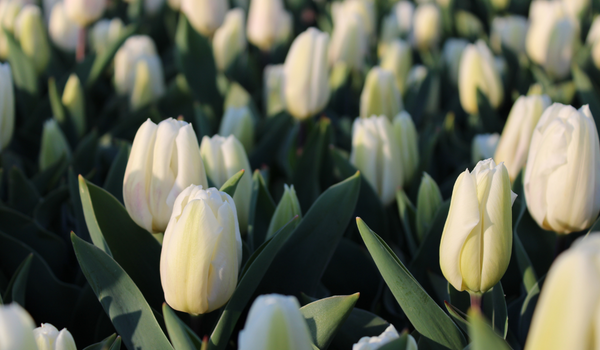How to care for Tulips? - The ultimate caring guide for Tulips
Tulips are renowned for their vibrant colors and elegant beauty, but to make them thrive year after year, you need to know the secrets of proper care. In this ultimate caring guide, we'll walk you through everything you need to know to ensure your tulips flourish. From planting and watering tips to pest control and seasonal maintenance, we've got you covered.
How to encourage bigger blooms in your Tulips
To encourage your tulips to produce larger, more vibrant blooms, follow these essential steps:
First, choose a sunny location with well-drained soil, as tulips thrive in full sun and dislike standing water. Next, ensure you plant them at the right depth, generally about 6-8 inches deep, and space them adequately to avoid overcrowding, which can inhibit growth. Incorporating organic matter into the soil before planting can provide essential nutrients.
Regular watering during the growing season is crucial, but be cautious not to overwater, as this can lead to bulb rot. Applying a balanced fertilizer with a higher phosphorus content in early spring when foliage emerges can support bigger flower development.
Finally, deadhead spent blooms to redirect the plant's energy into bulb development rather than seed production, and allow the foliage to wither naturally before removing it. These practices will help you achieve those stunning, larger tulip blooms you desire in your garden.

The right way to water Tulips: a guide for gardeners
Watering tulips daily is generally not recommended as it can lead to overwatering and root rot. Tulips prefer well-drained soil, and their watering needs vary depending on factors like weather and soil moisture. Typically, you should water tulips when the top inch of soil feels dry. In spring, when they are actively growing, a deep watering every 5-7 days should suffice unless there's consistent rainfall. During the dormant summer months, reduce watering significantly. However, it's essential to monitor the soil's moisture levels and adjust watering accordingly, ensuring it's sufficient but not excessive. This helps tulips thrive without the risk of waterlogged roots.
Tulip pinching: a technique for lush and colorful flowers
To ensure healthy tulip growth and vibrant blooms, it's essential to pinch or deadhead them when they reach a height of approximately 6 to 8 inches (15 to 20 centimeters). This practice encourages stronger stems and prevents the energy from being wasted on seed production, promoting larger and more colorful flowers. By removing the developing seed heads before they mature, you redirect the plant's resources into bulb development and storage, which leads to more robust bulbs for the following year. Pinching should be done carefully, snipping off the spent blooms just below the base, using clean, sharp pruners, to avoid damaging the plant
Supporting your Tulips: to stake or not to stake?
Tulips typically grow to a height of 10 to 24 inches (25 to 60 centimeters), depending on the variety. While many tulip varieties are sturdy and can support their blooms without staking, taller varieties or those in windy areas may benefit from staking. Staking helps prevent the stems from bending or breaking under the weight of the flowers, ensuring they stand tall and maintain their aesthetic appeal. To stake tulips, use slender stakes or bamboo sticks, placing them close to the plants and gently securing the stems with soft ties. This extra support can help your tulips reach their full height and bloom beautifully in your garden or flowerbed.

Choosing the perfect fertilizer for your Tulips
The best fertilizer for tulips is a balanced, slow-release granular fertilizer with an N-P-K ratio of approximately 10-10-10 or 14-14-14. This means it contains equal parts of nitrogen (N), phosphorus (P), and potassium (K), which are essential for healthy tulip growth. Additionally, tulips benefit from micronutrients like magnesium and calcium. It's crucial to apply this fertilizer in the early spring, just as the tulips begin to emerge, and avoid direct contact with the bulbs to prevent damage. Remember to follow the manufacturer's instructions for application rates, as over-fertilizing can harm your tulips. Regular feeding once a year, combined with well-drained soil and proper watering, will help your tulips thrive and produce vibrant, long-lasting blooms.
Homemade fertilizers: nourishing your Tulips naturally
Creating homemade fertilizer is not only cost-effective but also eco-friendly. Start by collecting kitchen scraps like coffee grounds, eggshells, and vegetable peels, which provide essential nutrients. Compost these materials in a bin or pile, ensuring a balance between 'green' (nitrogen-rich) and 'brown' (carbon-rich) components, such as leaves and shredded newspaper. Turn the compost regularly to aerate it.
For an extra nutrient boost, consider adding natural ingredients like Epsom salt for magnesium, crushed banana peels for potassium, or diluted fish tank water for beneficial microorganisms. Let the compost mature for several months until it's dark and crumbly. Then, sprinkle or mix it into your garden soil to nourish your flower bulbs, promoting healthy growth and vibrant blooms.
Mastering the art of dividing Tulips
To successfully divide tulips, start by digging up the bulbs after the foliage has withered, usually in late spring or early summer. Carefully lift the clump of bulbs from the ground, being mindful not to damage them. Shake off excess soil and inspect the bulbs for offsets, small bulbils attached to the main bulb. Gently separate these offsets from the parent bulb. Ensure each offset has roots attached and replant them at the appropriate depth, typically 3 times the bulb's height, in well-draining soil enriched with compost. Water thoroughly after planting, and your divided tulips will thrive, producing vibrant blooms in the next growing season.

What happens when you don’t divide Tulips
If you don't divide tulips regularly, they can become overcrowded and compete for nutrients, leading to smaller blooms and a decline in overall flower quality. Over time, this overcrowding can also make the bulbs more susceptible to diseases and pests. Dividing tulip bulbs every 3 to 5 years helps rejuvenate the plants, ensuring they have enough space to grow, access to nutrients, and room to produce healthy, vibrant blooms. Neglecting this essential maintenance task may result in a diminishing display of tulips in terms of both size and visual appeal, ultimately reducing the longevity of your tulip garden's beauty.
Post-bloom care: ensuring a colorful display year after year
After your tulips have finished flowering, it's essential to take proper post-bloom care to ensure their health and beauty in the next growing season. Start by deadheading the spent blooms. This means removing the faded flowers to prevent seed production, as it can weaken the bulb. Allow the foliage to wither and turn yellow naturally, as this process helps the bulb store energy for next year. Avoid cutting or tying the leaves prematurely. Once the leaves have fully yellowed, usually in late spring to early summer, you can carefully remove them. Be patient and resist the urge to trim too soon, as this allows the bulb to rejuvenate and ensures a vibrant display in the following spring.
You can leave the bulbs in the ground, but is also fine to lift the bulbs and store them in a cool, and dry place.
Can you leave Tulips in the ground year-round and over winter?
While tulips can survive in the ground year-round, it's beneficial to lift and store them for optimal results. Leaving tulip bulbs in the ground may lead to shorter growth in subsequent seasons. To ensure your tulips thrive, consider lifting the bulbs after they finish blooming and the foliage has withered. Store them in a cool, dry place until the next planting season. This practice helps protect the bulbs from extreme weather conditions and potential pests. When properly stored, tulip bulbs can produce taller, healthier blooms, enhancing the beauty of your garden year after year.

Do Tulips come back every year?
Tulips are indeed perennial flowers, meaning they have the potential to return each year. However, their ability to bloom annually can vary depending on several factors. In most cases, tulips will come back for a few years if you provide them with the right care. To maximize their return, plant tulip bulbs in well-draining soil and ensure they receive at least six hours of sunlight daily. After they bloom in spring, deadhead the flowers but allow the foliage to wither naturally. You can also fertilize with a balanced bulb fertilizer. Over time, some tulip varieties may gradually decline in vigor, while others, especially species tulips, are more likely to naturalize, producing blooms for many years without replanting.
When and how to cut back Tulips
The ideal time to cut back tulips is after their petals have withered and fallen, typically in late spring or early summer. It's important to wait until the tulip blooms have completed their natural life cycle and the petals start to fade and drop. This allows the tulip to divert energy back into the bulb for next year's growth. Using clean, sharp scissors or pruning shears, snip the flower stem just above the leaves, but avoid cutting the leaves themselves. The leaves continue to photosynthesize and nourish the bulb. Once the foliage turns yellow and begins to die back, usually several weeks after flowering, you can safely remove it. Properly timed cutting back helps tulips thrive and ensures a stunning display in the following spring.
Share
